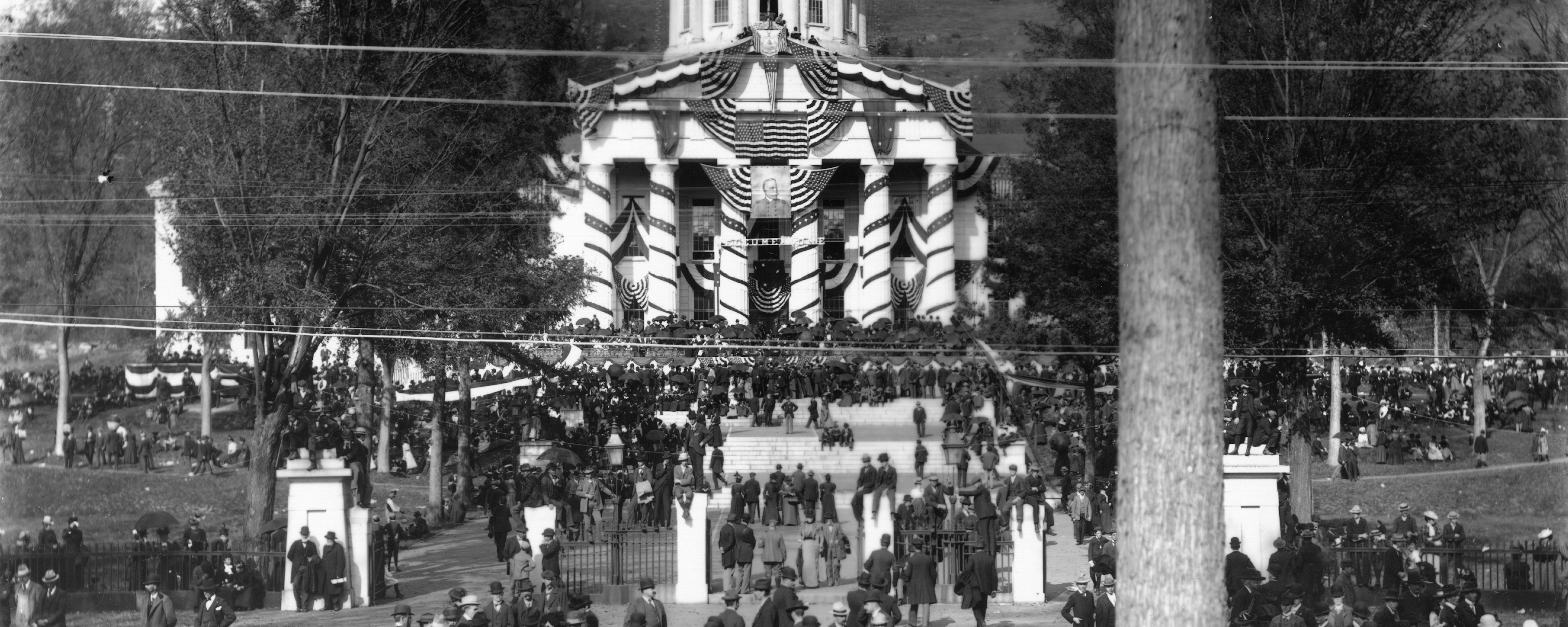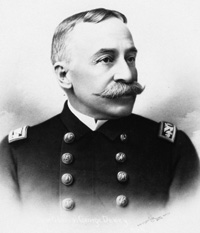Dewey Day: A Century Ends, 1899

The “Dewey Day” celebration in Vermont occurred in Montpelier on October 12, 1899. On that day Vermonters staged a historic welcome home for native son Admiral George Dewey, whose success in destroying the Spanish fleet at Manila Bay during the Spanish-American War made him the nation’s number one naval hero. Dewey’s exploit in the Philippines seemed to bring glory to Vermont and it became one the highlights of standard histories of the state.
Oral history transcriptions
Click a name below for more information. All transcripts are in PDF format.
Background information
 George Dewey was born in Montpelier in a house across from the state capital on December 26, 1837. He was the son of Dr. Julius Dewey, a well-known physician, and found and first president of the national Life Insurance Company. After graduating from Montpelier schools, he attended Norwich University (in Northfield Vermont) and in 1854 entered the Naval Academy at Annapolis, from which he graduated. As a career naval officer, he saw service during the Civil War on the steam frigate Mississippi. In January 1898, by now a commodore, Dewey took command of the Asiatic squadron in Nagasaki, Japan. In the next few months the US fought and won the war against Spain in Cuba during which Dewey led the conquest at Manila Bay without loss of a single American life. The Philippines victory was the most spectacular event of the Spanish-American War. It made the US an important power in the Pacific Ocean, and it made Dewey an immediate national hero.
George Dewey was born in Montpelier in a house across from the state capital on December 26, 1837. He was the son of Dr. Julius Dewey, a well-known physician, and found and first president of the national Life Insurance Company. After graduating from Montpelier schools, he attended Norwich University (in Northfield Vermont) and in 1854 entered the Naval Academy at Annapolis, from which he graduated. As a career naval officer, he saw service during the Civil War on the steam frigate Mississippi. In January 1898, by now a commodore, Dewey took command of the Asiatic squadron in Nagasaki, Japan. In the next few months the US fought and won the war against Spain in Cuba during which Dewey led the conquest at Manila Bay without loss of a single American life. The Philippines victory was the most spectacular event of the Spanish-American War. It made the US an important power in the Pacific Ocean, and it made Dewey an immediate national hero.
When Dewey returned to the US in September 1899, the national reaction bordered on the hysterical. Congress made him, first, a rear admiral, then created the rank of Admiral of the Navy especially for him. Private funds were contributed to buy him a home in Washington, D.C. Songs and poems were written about him. The journalist R. L. Duffus recalled in his memoir that in Vermont “children . . . were named Dewey. So were dogs, streets, and schools, even though “few knew where Manila was (Duffus, Waterbury Record, 201). Dewey made a triumphal tour of major American cities, from New York to San Francisco, during which he was deluged with loving cups and souvenirs.
Vermont’s own occasion to honor its native son had to await completion of the national tour. With Vermont “Dewey Day” set for October 12, the admiral made his return to the Green Mountain State on October 10, on a special train provided by Dr. William Seward Webb of Shelburne. At the state line in North Bennington, he was greeted by 1,000 people, including Governor Edward C. Smith. At Shelburne, where he stayed overnight, he was met by a 17-gun salute and a crowd of 3,000, including 200 flag-waving children. Next day Dewey boarded another special train, bound for Montpelier. The trip was slowed by several pre-arranged stops along the route, each accompanied by large receptions. He arrived in Montpelier on the evening of the 11th.
The next day, in Montpelier, Vermont, celebrated Dewey Day. Preparations had been two months in the making, under the responsibility of a committee appointed by the governor that included representatives from every county in the state. The Central Vermont Railroad, according to a newspaper report, built thirteen special tracks and a temporary station to handle the trains bringing Vermonters into Montpelier for the occasion. Grandstands were erected along the line of the parade to help accommodate the estimated 40,000 people who crowded into downtown streets. Montpelier’s mayor appointed special policemen to assist in managing the crowds. The town’s buildings and the State House were draped in red, white, and blue bunting. A large portrait of Dewey and 1,555 electric lights for night-time illumination also adorned the State House. An illuminated “Welcome Home” sign hung above the porch of the Pavilion Hotel, and most of the town’s dwelling houses were also lighted with decorations.
A parade and a fireworks display highlighted the day’s events. Dewey led the parade in full dress uniform and feathered hat, riding in an open horse-drawn carriage. Included in the elaborate, 500-participant line of march were veterans’ group, fraternal groups, local bands, and other organizations. According to accounts, Dewey smiled and waved to swarms of children who jammed against the picket fence that surrounded the State House grounds calling for his attention. Dewey eventually mounted the reviewing stand where, along with 1,000 distinguished guests, he observed the proceedings. A witness reported that “the whole line of march was an ovation, the crowd yelling itself hoarse along the entire route.” “All went wild,” another observer reported (Across the Onion, 213). The festivities included a presentation to Dewey by the state of a gold badge spelling out “welcome home” in diamonds, struck by Tiffany Company of New York City.
That evening, in Montpelier’s Langdon meadow, a huge fireworks display climaxed the day. “Set pieces of the Olympia [Dewey’s flagship], the Battle of Manila, a likeness of Admiral Dewey, and a view of the State House flamed their way across the evening sky.” Also included were “1,000 exhibition candles, rockets by the 100’s, 75 mammoth meteors, and 100’s of pounds of colored fire, all topped off by the lighting of the bonfire extraordinaire on Capital Hill.”
Witnesses were convinced that Dewey Day was perhaps the grandest occasion Vermont had ever seen. Historian Kevin Graffagnino has observed that there was more to the spectacular day “than just a manifestation of Vermont’s admiration for the hero of Manila Bay.”
Dewey Day was also the last of the late-nineteenth-century occasions that brought together tens of thousands of Vermonters to mark a momentous event in their history, observe the great and near-great leaders of their day, and listen to orations linking the past, present, and future of their state. . . . By the time of Vermont’s next great celebration, the Champlain Tercentenary of 1909, the generation which had helped shape the destiny of the state after the Civil War would step aside for a different set of men and women to chart Vermont’s course. Continuity . . . would still serve Vermont well, yet it would be change that became the dominant half of the equation in the years after Dewey Day (Graffagnino, Vermont in the Victorian Age, 141).
—Gene Sessions
January 1987
Further reading
[Forbes, Charles S.], “Admiral Dewey at Home,” The Vermonter, 5:4 (November 1899), 63-79.
Graffagnino, J. Kevin, Vermont in the Victorian Age: Continuity and Change in the Green Mountain State, 1850-1900 (Bennington and Shelburne, Vt.: Vermont Heritage Press and Shelburne Museum, 1985): 138-141.
For biographical treatments of Dewey, see Ronald Spector, Admiral Dewey of the New Empire: The Life and Career of George Dewey (Baton Rouge: Louisiana State University Press, 1974); and Laurin Hall Healy and Luis Kutner, The Admiral (Chicago, New York, Ziff-Davis Publishing Company, 1944).
Citation for this page
Woodsmoke Productions and Vermont Historical Society, “Dewey Day: A century Ends,” The Green Mountain Chronicles radio broadcast and background information, original broadcast 1988-89. https://vermonthistory.org./dewey-day-a-century-ends-1899